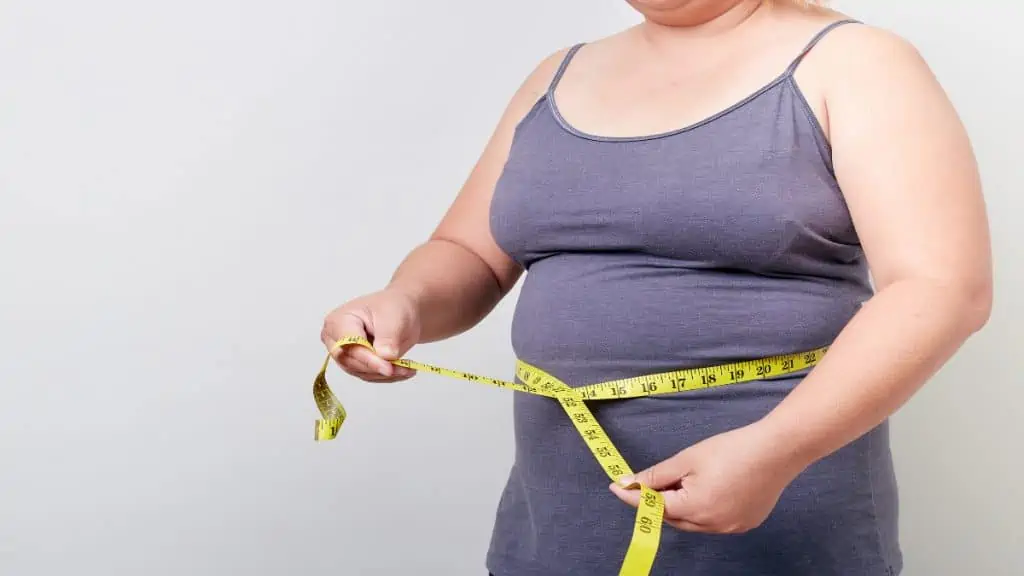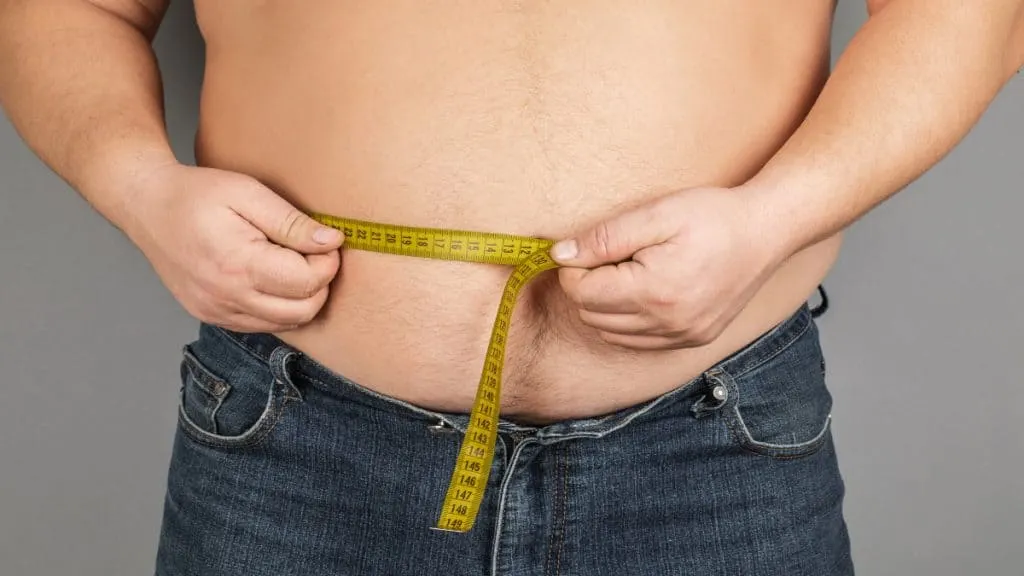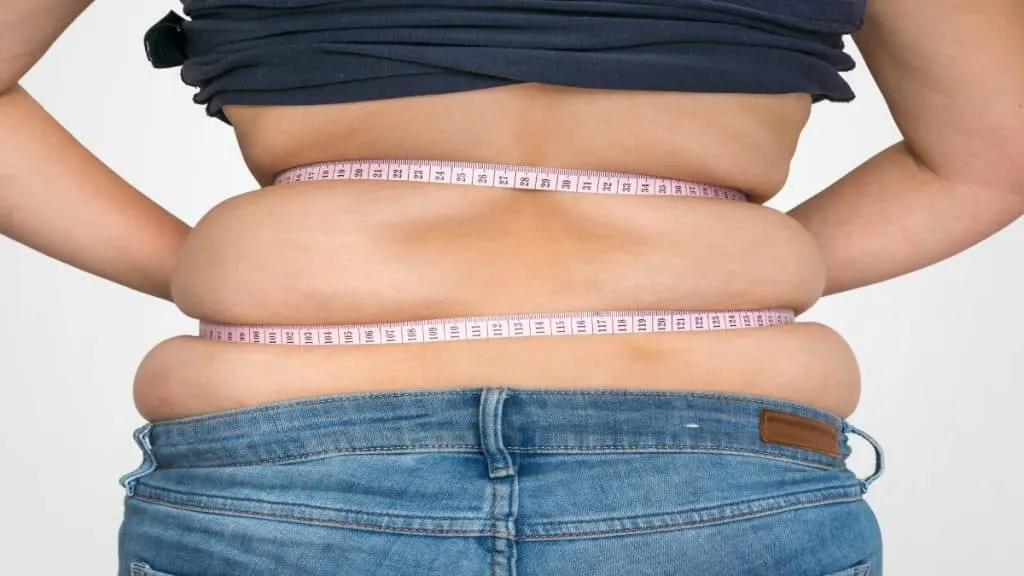42 inches is a couple of inches bigger than the average male waist size and approximately 4 inches bigger than average for a woman.
Considering that the average measurement is already too high for an individual to live in optimal health, it’s highly likely that you’re increasing your risk of chronic disease by having a 42″ waist.
The good news is that you can shed your stomach fat by following a few proven exercise and diet tips. More on that later.
See How Your Waist Stacks Up:
- 40 inch waist
- 41 inch waist
- 43 inch waist
- 44 inch waist
- 45 inch waist
- 46 inch waist
- 47 inch waist
- 48 inch waist
- 49 inch waist
Is a 42 inch waist large for a woman?

Is a 42 inch waist too large for a woman to be healthy? While you can definitely be happy with your body while having a 42 in waist, you can’t live in good health as a female if you have a 42 inch waist.
This is because having a 42 inch waistline is indicative of having excess visceral fat, which is a dangerous type of fat that can surround your vital organs, causing cancer, diabetes, and heart disease. [1]
Of course, women with larger builds are likely to have a thicker waist. Additionally, some ladies store a disproportionate amount of body fat around their waistline.
Still, having a 42″ waist as a woman means that you’re well above the threshold for being considered high risk of chronic disease. See the section on slimming your waist for some advice on how to safely and effectively reduce your waist measurement.
Is a 42 inch waist big for a man?

Yes, even though men naturally have bigger waists than women due to having a larger bone structure and more muscle mass, a 42 inch waist is still too big for a man to live in his best health.
Although only two inches bigger than the average measurement, a 42 inch waist is still around 5-7 inches bigger than the threshold for being considered at a low risk of chronic disease.
Here’s a good way to work out just how big your 42 inch belly is: Double the value (your waist size) and compare it to your height in inches. Ideally, you should have a waist-to-height ratio of less than 0.5 if you want to live life in good health. [2]
So, based on this ratio, unless you’re exceptionally tall, there’s no way that you can enjoy your best physical health while having a 42 inch waist.
What does a 42 inch waist look like on a person?

A 42 inch waist will typically look large on both men and women because it’s a bigger than average circumference measurement. That said, there are a few factors that influence what any given waistline looks like. Additionally, there are a few tactics that you can implement right now to make your 42 inch stomach look smaller than it actually is.
The taller that you are, the smaller that your 42 inch waist size will look. This is because when you’re tall as opposed to short, a given waist measurement represents a smaller overall surface area of your body.
Additionally, if you have a muscular core from training your abs and obliques at the gym, then it’s possible to thicken your waist without actually making it fatter. Of course, most people can’t build a 42 in waist of pure muscle, so even if you lift weights regularly, it’s highly likely that a good deal of your 42″ waist consists of fat in addition to muscle tissue.
As for what you can do now to make your midsection look smaller, eating a healthy meal and performing some exercise are obviously your two best options. However, you can also wear loose-fitting clothing and extra layers, which will help to make your belly less visible.
How can you slim a 42 in waist successfully?

As any nutritionist will tell you, losing weight comes down to putting your body in an energy deficit. To create this energy deficit, you typically need to consume fewer calories (around 500 fewer per day) than your body needs to maintain its current weight.
Some people may be able to create the required energy deficit by simply increasing their activity level, which is especially true if you’ve previously been close to completely sedentary and are now embarking on a near-daily exercise regime.
Still, most individuals will need to lower their calories in order to shed their stomach fat.
On the exercise side of things, focus on full-body movements most of the time. Compared to isolation exercises, which still have their place for sculpting your physique, full-body movements burn more calories and work more muscles, which means that they also challenge your cardiovascular system to a greater extent.
Burpees and mountain climbers are two great examples of such exercise. [3] You can do them virtually anywhere—equipment free—and they work your abs directly, something that can help your torso to look more toned and muscular once you shed the fat.
Conclusion: How long does it take to see results?

Weight loss doesn’t happen overnight, and you’re unlikely to see drastic physical changes within the first couple of weeks. However, you can see great results in just 8-12 weeks if you consume a healthy diet and follow a consistent exercise regime.
Just avoid slashing your calories on day one. It’s fine to lose 1-2 pounds a week (and maybe slightly more initially, as the water weight declines in your body due to the calorie deficit), but you shouldn’t overdo things.
Bear in mind that if you’re building muscle at the same time as you’re shedding fat, something that’s called body recomposition, you might not lose masses of actual weight. Take weekly waist measurements so that you can assess your fat loss progress.
References
- Janssen, I., Katzmarzyk, P. T., & Ross, R. (2002). Body Mass Index, Waist Circumference, and Health Risk. Archives of Internal Medicine, 162(18), 2074. https://doi.org/10.1001/archinte.162.18.2074
- Ashwell, M., Gunn, P., & Gibson, S. (2011). Waist-to-height ratio is a better screening tool than waist circumference and BMI for adult cardiometabolic risk factors: systematic review and meta-analysis. Obesity Reviews, 13(3), 275–286. https://doi.org/10.1111/j.1467-789x.2011.00952.x
- Groth, L. (2021, December 9). 15 Best Exercises to Burn Belly Fat, According to Personal Trainers. Prevention. https://www.prevention.com/fitness/g20459708/best-workouts-to-target-belly-fat/

